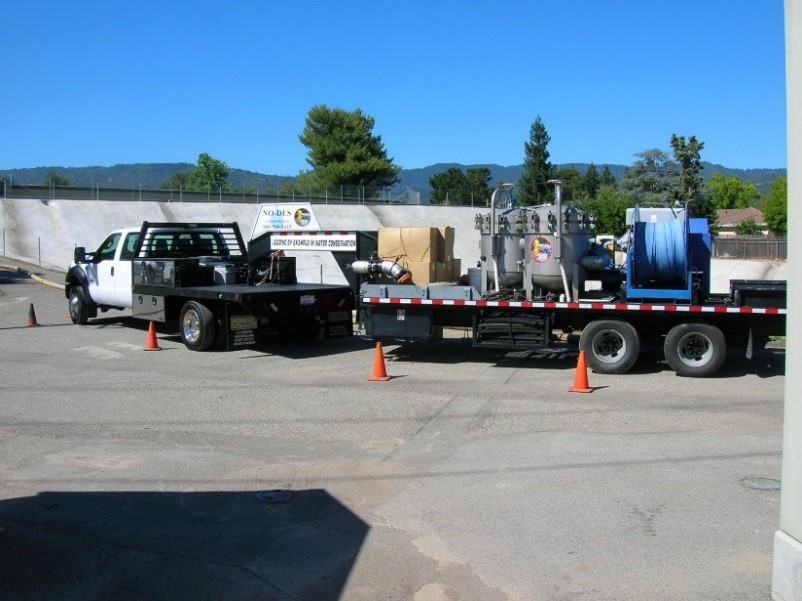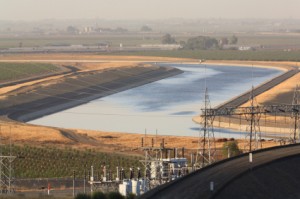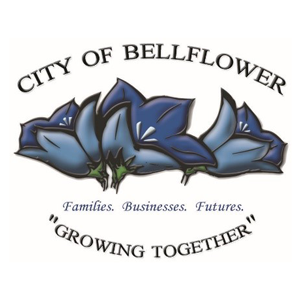Water utilities have routinely engaged in flushing their water systems to eliminate sediments and minimize discoloration to maintain water quality. However, with the drought entering its fourth year, investor-owned water utilities (IOUs) are now balancing the importance of maintaining water quality with the need to conserve a precious resource; therefore, routine water flushing is no longer the protocol.
The systematic process of water flushing includes opening and closing multiple hydrants at a time to force water through the pipes to flow into storm drains at a higher speed until the water is clear (see photos below). Many of California’s IOUs rely mainly on a flushing process known as unidirectional flushing, which isolates sections of the water main and uses a single hydrant to remove sediments.
“To maintain water quality, California Water Service Company (Cal Water) has and continues to rely on unidirectional flushing,” said Cal Water’s Manager of Water Quality Tarrah Henrie. “Although we stopped routine flushing in February 2014 due to the drought, we are required to flush in some instances, and by flushing only those sections that need attention, this is a responsible way to conserve water while ensuring our system is clean and healthy”
In light of the drought, many water utilities have implemented a flushing policy that kicks in only when there is a high need to flush or in response to customer inquiries, but ongoing maintenance of valves continues to ensure they are working properly. Although unidirectional flushing brings with it additional equipment and planning costs, Cal Water believes those costs are worth it in light of maintaining water quality and creating a positive public perception of responsible water use during the drought.
San Jose Water Company (SJWC) also believes in setting a good example. Its routine, unidirectional flushing program was suspended in May, and now SJWC only flushes in response to consumer calls or complaints or if SJWC staff finds an issue.
According to SJWC Vice President of Operations Andrew Gere, “Although we flush intermittently in light of the drought, our flushing schedule had already slowed to three miles a week before the drought, as opposed to our original target of six and a half miles per week. This is due to the more stringent discharge requirements placed on utilities.” Gere goes on to explain, “At one time, we were able to flush into a storm drain using a diffuser, but now the environmental protections, such as ensuring chlorinated water and sediments don’t enter into the storm drains, are so labor intensive that production crews have had to slow down to ensure compliance.”
SJWC has a long-term strategy to address flushing production requirements while maintaining water quality. The IOU has piloted a closed-loop flushing system (see photo of No-Des equipment below), which relies on a new piece of equipment for unidirectional flushing. Rather than having the water flush into the storm drain, SJWC can, in effect, conduct “dialysis” on the water, filtering out sediments then returning the water to the distribution system. And, instead of going hydrant to hydrant, SJWC will be able to do multiple flushes from one location, which increases efficiency while decreasing costs in the long run.
When asked how he knows if the flushing program works, Gere said, “Before instituting the flushing program in 1996, we had close to 350 customer contacts in a year, but looking back over the last 10 years, the highest number of contacts has been about 50 in a year. SJWC has approximately 220,000 service connections and 2,400 miles of water main serving close to a million residents. Our multi-pronged approach to improving and maintaining water quality and reducing bacterials is working based on this data.”
Both Cal Water and SJWC actively communicate with customers during drought and non-drought periods letting their customers know when they are flushing. In light of heightened awareness around the importance of conserving, both written materials and field staff emphasize that IOUs are required by the California Department of Public Health to flush water and also are committed to ensuring water quality for their customers.
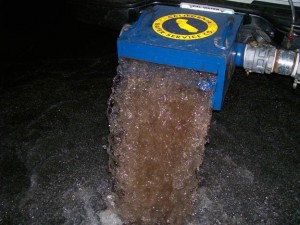
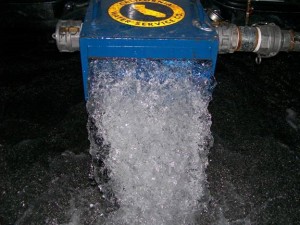 Cal Water Truck-mounted Diffuser with Dechlorination at the Beginning of a Flush and at the End
Cal Water Truck-mounted Diffuser with Dechlorination at the Beginning of a Flush and at the End

